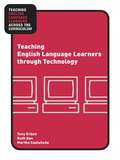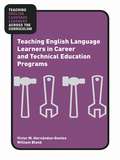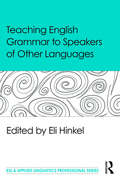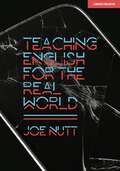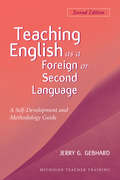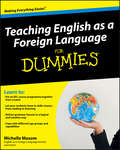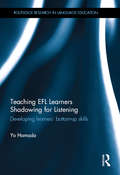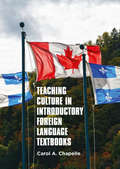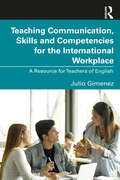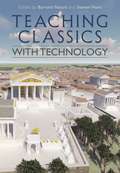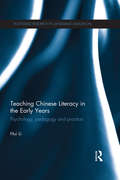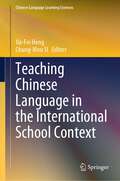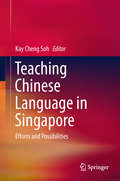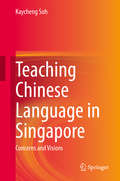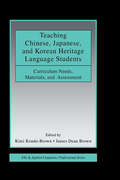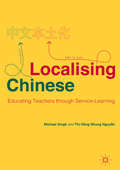- Table View
- List View
Teaching English Language Learners through Technology
by Tony Erben Ruth Ban Martha CastañedaIn Teaching English Language Learners through Technology, the authors explore the use of computers/technology as a pedagogical tool to aid in the appropriate instruction of ELLs across all content areas. The special focus of this book is on the informed use of various technologies and software programs that can specifically aid ELLs. Strategies are also provided for varying levels of access--whether teachers teach in a one computer classroom, have access to multiple computers, or have the ability to go into a computer lab at their school. A fully annotated list of web and print resources completes the volume, making this a valuable reference to help teachers harness the power of computer-assisted technologies in meeting the challenges of including all learners in effective instruction.
Teaching English Language Learners through Technology
by Tony Erben Ruth Ban Martha CastañedaIn Teaching English Language Learners through Technology, the authors explore the use of computers/technology as a pedagogical tool to aid in the appropriate instruction of ELLs across all content areas. The special focus of this book is on the informed use of various technologies and software programs that can specifically aid ELLs. Strategies are also provided for varying levels of access--whether teachers teach in a one computer classroom, have access to multiple computers, or have the ability to go into a computer lab at their school. A fully annotated list of web and print resources completes the volume, making this a valuable reference to help teachers harness the power of computer-assisted technologies in meeting the challenges of including all learners in effective instruction.
Teaching English Language Learners in Career and Technical Education Programs
by Victor M. Hernández-Gantes William BlankExploring the unique challenges of vocational education, this book provides simple and straightforward advice on how to teach English Language Learners in today's Career and Technical Education programs. The authors' teaching framework and case studies draw from common settings in which career and technical educators find themselves working with ELLs—in the classroom, in the laboratory or workshop, and in work-based learning settings. By integrating CTE and academic instruction, and embedding career development activities across the curriculum, readers will gain a better understanding of the challenges of teaching occupationally-oriented content to a diverse group of learners in multiples settings.
Teaching English Language Learners in Career and Technical Education Programs
by Victor M. Hernández-Gantes William BlankExploring the unique challenges of vocational education, this book provides simple and straightforward advice on how to teach English Language Learners in today's Career and Technical Education programs. The authors' teaching framework and case studies draw from common settings in which career and technical educators find themselves working with ELLs—in the classroom, in the laboratory or workshop, and in work-based learning settings. By integrating CTE and academic instruction, and embedding career development activities across the curriculum, readers will gain a better understanding of the challenges of teaching occupationally-oriented content to a diverse group of learners in multiples settings.
Teaching English Grammar to Speakers of Other Languages (ESL & Applied Linguistics Professional Series)
by Eli HinkelThis practical and research-based introduction to current and effective English grammar instruction gives pre-service and in-service teachers and teacher educators a strong foundation for teaching second language grammar and helps them develop their professional knowledge and skills. Written in a highly readable style for an international audience, it provides a thorough and rounded overview of the principles, strategies, techniques, and applications currently dominant in teaching L2 grammar in a range of instructional settings around the world. Chapter authors are world-class authorities in grammar and grammar teaching and learning. All chapters are based on theoretical frameworks and/or research foundations with a strong emphasis on practical applications and implications for classroom teaching, and highlight teaching methods, key concepts, and terminology associated with grammar instruction. Illuminating the options and choices in grammar teaching from a contemporary perspective, Teaching English Grammar to Speakers of Other Languages is ideal as key text for students in undergraduate and graduate MA-TESOL programs and as a resource for practicing ESL/EFL teachers, teacher educators, and teaching faculty.
Teaching English Grammar to Speakers of Other Languages (ESL & Applied Linguistics Professional Series)
by Eli HinkelThis practical and research-based introduction to current and effective English grammar instruction gives pre-service and in-service teachers and teacher educators a strong foundation for teaching second language grammar and helps them develop their professional knowledge and skills. Written in a highly readable style for an international audience, it provides a thorough and rounded overview of the principles, strategies, techniques, and applications currently dominant in teaching L2 grammar in a range of instructional settings around the world. Chapter authors are world-class authorities in grammar and grammar teaching and learning. All chapters are based on theoretical frameworks and/or research foundations with a strong emphasis on practical applications and implications for classroom teaching, and highlight teaching methods, key concepts, and terminology associated with grammar instruction. Illuminating the options and choices in grammar teaching from a contemporary perspective, Teaching English Grammar to Speakers of Other Languages is ideal as key text for students in undergraduate and graduate MA-TESOL programs and as a resource for practicing ESL/EFL teachers, teacher educators, and teaching faculty.
Teaching English for the Real World
by Joe NuttSo much of the teaching in schools of how the English works does not prepare students for the real world. So little has changed in exams, the curriculum, or the way people think about English teaching, in several decades. This book is Joe Nutt's attempt to help schools redress that dramatic imbalance. It's not in any sense a practical teaching guide only for English teachers, nor is it full of hints and tips, lesson plans and schemes of work. Teaching English for the Real World is a far wider consideration of what schools and English teachers should be doing if they wish to prepare secondary school children to be successful and effective users of English, in the real world of work, higher education and adult life they will all too soon enter. If you are an English teacher, by the time you finish reading Teaching English for the Real World, you should be better prepared to deliver lessons that those you teach will forever be grateful for. The book consists of four main sections: English in context, towards the GCSE, choosing texts and technology matters. It starts by putting English clearly into context through a range of current examples. It urges teachers to consider the complex role English usage plays on everything from the side of a bus, through tissue-thin social media, garish slideshows and perky TED talks, to the hundreds of pages of research or official reports so often used as the basis for serious political policy and commercial decision making. It will then examine the classroom status quo and instead of the unrealistic and damaging focus on experiment and creativity, instead of requiring them to write newspaper articles, stories or speeches, the main deliverables in any English GCSE exam, the book will argue that teachers should think carefully about how to connect what children write, with who they are and where they really want to publish. The next section deals with choices of texts. There is a place for children to be taught to write well by example, but there are challenging questions to ask about much of the material routinely chosen. How often are texts and authors selected for study, for reasons that have absolutely nothing whatsoever to do with knowledge or linguistic skill, and everything to do with politics? Even exam boards are guilty of this. The final section examines the relationship between English and the technology real people use to produce it. It reflects on how technology has impacted on the quality of the reading experience itself and argue that there is a crisis in reading in secondary schools, with many children sailing through exams yet leaving school as disinterested and even poor readers. And it suggests how teachers might approach introducing these different risks to children and equip them best to make sound judgements about the way they write and communicate, for personal and employment purposes in adult life.
Teaching English as a Foreign or Second Language, Second Edition: A Teacher Self-Development and Methodology Guide
by Jerry G. GebhardTeaching English as a Foreign or Second Language, Second Edition, is designed for those new to ESL/EFL teaching and for self-motivated teachers who seek to maximize their potential and enhance the learning of their students. This guide provides basic information that ESL/EFL teachers should know before they start teaching and many ideas on how to guide students in the skills of listening, speaking, reading, and writing. It stresses the multifaceted nature of teaching the English language to non-native speakers and is based on the real experiences of teachers. The second edition of Teaching English as a Foreign or Second Language includes a wider range of examples to coincide with a variety of teaching contexts-from K-12 schools, to university intensive language programs and refugee programs. It is also updated with discussions of technology throughout, and it considers ways in which technology can be used in teaching language skills. Sources for further study are included in each chapter and in the appendixes.
Teaching English as a Foreign Language For Dummies
by Michelle MaxomLearn to: Put an EFL course programme together from scratch Let your students loose in skills classes – from reading to listening Deliver grammar lessons in a logical and intuitive way Cope with different age groups and capabilities Your one-stop guide to a career that will take you places If you thought that teaching a language that's second nature to you would be easy, think again! Explaining grammar, or teaching correct pronunciation while simultaneously developing your own skills as a teacher can be a huge challenge. Whether you're on a training course or have already started teaching, this book will help launch your career and give you the confidence and expertise you need to be a brilliant teacher. Make an educated decision – decide between the various courses, qualifications and job locations available to you Start from scratch – plan well-structured lessons and develop successful and effective teaching techniques Focus on skills – from reading and writing, to listening and speaking, get your students sounding and feeling fluent Get your head around grammar – teach students to put sentences together, recognise tenses and use adjectives and adverbs All shapes and sizes – tailor your lessons to younger learners, one-to-ones, exam classes and Business English learners Open the book and find: TEFL, TESOL, EFL – what all the acronyms mean The best course books and materials to supplement your teaching Advice on running your class and handling difficulties Lesson plans that you can use in the classroom Activities and exercises to keep your students on their toes Constructive ways to correct and assess your students' performance Ways to inject some fun into your classes Insider information on the best jobs around the world 'An invaluable manual for anyone thinking of embarking on a TEFL journey. Michelle Maxom's step-by-step guide provides practical tips to get you started and offers key advice to help unleash the creative English language teacher within.' – Claire Woollam, Director of Studies & a Teacher Trainer at Language Link London
Teaching English as a Foreign Language For Dummies
by Michelle MaxomLearn to: Put an EFL course programme together from scratch Let your students loose in skills classes – from reading to listening Deliver grammar lessons in a logical and intuitive way Cope with different age groups and capabilities Your one-stop guide to a career that will take you places If you thought that teaching a language that's second nature to you would be easy, think again! Explaining grammar, or teaching correct pronunciation while simultaneously developing your own skills as a teacher can be a huge challenge. Whether you're on a training course or have already started teaching, this book will help launch your career and give you the confidence and expertise you need to be a brilliant teacher. Make an educated decision – decide between the various courses, qualifications and job locations available to you Start from scratch – plan well-structured lessons and develop successful and effective teaching techniques Focus on skills – from reading and writing, to listening and speaking, get your students sounding and feeling fluent Get your head around grammar – teach students to put sentences together, recognise tenses and use adjectives and adverbs All shapes and sizes – tailor your lessons to younger learners, one-to-ones, exam classes and Business English learners Open the book and find: TEFL, TESOL, EFL – what all the acronyms mean The best course books and materials to supplement your teaching Advice on running your class and handling difficulties Lesson plans that you can use in the classroom Activities and exercises to keep your students on their toes Constructive ways to correct and assess your students' performance Ways to inject some fun into your classes Insider information on the best jobs around the world 'An invaluable manual for anyone thinking of embarking on a TEFL journey. Michelle Maxom's step-by-step guide provides practical tips to get you started and offers key advice to help unleash the creative English language teacher within.' – Claire Woollam, Director of Studies & a Teacher Trainer at Language Link London
Teaching EFL Learners Shadowing for Listening: Developing learners' bottom-up skills (Routledge Research in Language Education)
by Yo HamadaShadowing, an active and highly cognitive technique for EFL listening skill development, in which learners track heard speech and vocalize it simultaneously, is gradually becoming recognized. However, there remain a lot of mysteries and misunderstandings about it. This book uncovers shadowing in terms of theory and practice. This book cements shadowing as a separate technique from other similar techniques such as Elicited Imitation, Mirroring, and simple repetition, and provides ample empirical data to explain the function of Shadowing. It also elaborates on how Shadowing should be used in terms of materials, procedure, and learners’ psychology, which would aid in instructors’ use of Shadowing in teaching. A guide on a method effective in improving learners’ bottom-up listening skills, this book will certainly prove useful to English Language learners and instructors in their linguistic pursuits.
Teaching EFL Learners Shadowing for Listening: Developing learners' bottom-up skills (Routledge Research in Language Education)
by Yo HamadaShadowing, an active and highly cognitive technique for EFL listening skill development, in which learners track heard speech and vocalize it simultaneously, is gradually becoming recognized. However, there remain a lot of mysteries and misunderstandings about it. This book uncovers shadowing in terms of theory and practice. This book cements shadowing as a separate technique from other similar techniques such as Elicited Imitation, Mirroring, and simple repetition, and provides ample empirical data to explain the function of Shadowing. It also elaborates on how Shadowing should be used in terms of materials, procedure, and learners’ psychology, which would aid in instructors’ use of Shadowing in teaching. A guide on a method effective in improving learners’ bottom-up listening skills, this book will certainly prove useful to English Language learners and instructors in their linguistic pursuits.
Teaching Culture in Introductory Foreign Language Textbooks
by Carol A. ChapelleThis book demonstrates how foreign language textbook analysis can inform future materials development to improve foreign language teaching. Through chronological analysis of French textbooks in the United States, this book explores the representations of Canada and Quebec in French beginner textbooks produced from 1960 to 2010. Chapelle couples a large collection of 65 textbooks with a social-semiotic qualitative analysis of the genres, language and images that communicate Quebec's cultural narrative to learners. Findings about the amount and type of content are presented by decade to track the trends in foreign language teaching and changes in Quebec’s representation. Particular attention is given to how language politics is presented to students through text and images. This book will be of interest to scholars of Canadian Studies, Quebec Studies and Second Language Acquisition, as well as foreign language materials developers.
Teaching Communication, Skills and Competencies for the International Workplace: A Resource for Teachers of English
by Julio GimenezBacked by evidence and research, this practical book presents an innovative yet comprehensive approach to teaching non-native English speakers the main communication and cultural competencies that are required to succeed in an international English-speaking workplace. Each unit includes strategies for teaching key skills, tasks to encourage reflection and notes on relevant cultural and technological issues. Practical features in each unit include lesson plans and materials, insights from research, extension tasks, reflection activities and further readings. Supported by current learning theories, key teaching methodologies and assessment materials, the chapters address the challenges that non-native English speakers may face in the international English-speaking workplace. Areas of focus include: Job hunting Job applications Interviews Interpersonal, written and spoken communication Performance appraisals Applying for promotions Written for pre-service, practicing and future teachers, with specific guidance for each role, this is an essential resource for all educators who want to confidently address the challenges that non-English speakers may encounter at work, including linguistic proficiency, cultural awareness and the use of technology.
Teaching Communication, Skills and Competencies for the International Workplace: A Resource for Teachers of English
by Julio GimenezBacked by evidence and research, this practical book presents an innovative yet comprehensive approach to teaching non-native English speakers the main communication and cultural competencies that are required to succeed in an international English-speaking workplace. Each unit includes strategies for teaching key skills, tasks to encourage reflection and notes on relevant cultural and technological issues. Practical features in each unit include lesson plans and materials, insights from research, extension tasks, reflection activities and further readings. Supported by current learning theories, key teaching methodologies and assessment materials, the chapters address the challenges that non-native English speakers may face in the international English-speaking workplace. Areas of focus include: Job hunting Job applications Interviews Interpersonal, written and spoken communication Performance appraisals Applying for promotions Written for pre-service, practicing and future teachers, with specific guidance for each role, this is an essential resource for all educators who want to confidently address the challenges that non-English speakers may encounter at work, including linguistic proficiency, cultural awareness and the use of technology.
Teaching Classics with Technology
by Bartolo Natoli Steven HuntThe impact of ICT on the teaching of classical languages, literature and culture has not until now been extensively described and evaluated. Nevertheless, educational technology has made a huge difference to the ways in which Classics is taught at junior, senior and college level. The book brings together twenty major approaches to the use of technology in the classroom and presents them for a wide, international audience. It thus forms a record of current and developing practice, promotes further discussion and use among practitioners (teachers, learners and trainers) and offers suggestions for changes in pedagogical practices in the teaching of Classics for the better. The many examples of practice from both UK and US perspectives are applicable to countries throughout the world where Classics is being taught. The more traditional curricula of high-school education in the UK and Europe are drawing more and more on edutech, whereas educational jurisdictions in the US are increasingly expecting high-school students to use ICT in all lessons, with some actively dissuading schools from using traditional printed textbooks. This book presents school teachers with a vital resource as they adapt to this use of educational technology in Classics teaching. This is no less pertinent at university level, in the UK and US, where pedagogy tends to follow traditionalist paradigms: this book offers lecturers frameworks for understanding and assimilating the models of teaching and learning which are prevalent in schools and experienced by their students.
Teaching Classics with Technology
by Bartolo Natoli Steven HuntThe impact of ICT on the teaching of classical languages, literature and culture has not until now been extensively described and evaluated. Nevertheless, educational technology has made a huge difference to the ways in which Classics is taught at junior, senior and college level. The book brings together twenty major approaches to the use of technology in the classroom and presents them for a wide, international audience. It thus forms a record of current and developing practice, promotes further discussion and use among practitioners (teachers, learners and trainers) and offers suggestions for changes in pedagogical practices in the teaching of Classics for the better. The many examples of practice from both UK and US perspectives are applicable to countries throughout the world where Classics is being taught. The more traditional curricula of high-school education in the UK and Europe are drawing more and more on edutech, whereas educational jurisdictions in the US are increasingly expecting high-school students to use ICT in all lessons, with some actively dissuading schools from using traditional printed textbooks. This book presents school teachers with a vital resource as they adapt to this use of educational technology in Classics teaching. This is no less pertinent at university level, in the UK and US, where pedagogy tends to follow traditionalist paradigms: this book offers lecturers frameworks for understanding and assimilating the models of teaching and learning which are prevalent in schools and experienced by their students.
Teaching Chinese Literacy in the Early Years: Psychology, pedagogy and practice (Routledge Research in Language Education)
by Hui LiThe Chinese language is now used by a quarter of the world’s population and is increasingly popular as a second language. Teaching Chinese Literacy in the Early Years comprehensively investigates the psychology, pedagogy and practice involved in teaching Chinese literacy to young children. This text not only explores the psycholinguistic and neuropsychological processing involved in learning Chinese literacy but also introduces useful teaching methods and effective practices relevant for teaching within early years and primary education. Key issues explored within this text include: The Psycholinguistics of Chinese Literacy Neuropsychological Understanding of Chinese Literacy The pedagogy of teaching Chinese as a first language The Pedagogy of Teaching Chinese as a second language Teaching Chinese literacy in early childhood settings Assessing Chinese Literacy Attainment in the Early Years With the addition of two reliable Chinese literacy scales, Teaching Chinese Literacy in the Early Years is an essential text for any student, lecturer or professional teacher who is interested in learning and teaching Chinese literacy.
Teaching Chinese Literacy in the Early Years: Psychology, pedagogy and practice (Routledge Research in Language Education)
by Hui LiThe Chinese language is now used by a quarter of the world’s population and is increasingly popular as a second language. Teaching Chinese Literacy in the Early Years comprehensively investigates the psychology, pedagogy and practice involved in teaching Chinese literacy to young children. This text not only explores the psycholinguistic and neuropsychological processing involved in learning Chinese literacy but also introduces useful teaching methods and effective practices relevant for teaching within early years and primary education. Key issues explored within this text include: The Psycholinguistics of Chinese Literacy Neuropsychological Understanding of Chinese Literacy The pedagogy of teaching Chinese as a first language The Pedagogy of Teaching Chinese as a second language Teaching Chinese literacy in early childhood settings Assessing Chinese Literacy Attainment in the Early Years With the addition of two reliable Chinese literacy scales, Teaching Chinese Literacy in the Early Years is an essential text for any student, lecturer or professional teacher who is interested in learning and teaching Chinese literacy.
Teaching Chinese Language in the International School Context (Chinese Language Learning Sciences)
by Jia-Fei Hong Chung-Mou SiThis book explores the learning and teaching of K-12 Chinese language in international schools. The authors of this book are scholars from teaching training institutions and universities, as well as professional frontline teachers. With a combination of the works and insights from both perspectives of theory and practice, the book presents how theories of teaching can be operated in classroom to improve the effectiveness of language teaching. It covers curriculum setting, design of teaching materials, teaching principles, methods, strategies, and evaluation. The book also discusses issues and concepts such as concept-driven learning, identity change and recognition of L1 and L2 Chinese teacher, pinyin teaching, Chinese character teaching, evaluation for learning improvement, and integration of South Asian non-Chinese speaking students into local schools. It emphasizes empirical action research methods. This is a highly informative and carefully presented book, providing high value insights to scholars from university and teacher training institutions and teachers from kindergartens, primary, and secondary schools around the world.
Teaching Chinese Language in Singapore: Efforts and Possibilities
by Kay Cheng SohThis book presents the experiences of Chinese Language researchers in Singapore to Chinese Language researchers and teachers in other countries and regions, such as the USA, the UK and Asia, that are home to a large number of learners, young and old. As such, the innovative ideas it provides can be applied in practising teachers’ classrooms to promote more effective and efficient student learning. Beyond pedagogical innovations, the book also includes papers on the assessment of Chinese Language learning and teacher literacy – two areas that have been largely neglected by the Chinese Language research and teaching communities, not only here in Singapore, but also around the world. This book, the sequel to “Teaching Chinese Language in Singapore: Retrospect and Challenges” (Springer, 2016), is future-oriented, highlighting ideas that merit further attention from researchers and practitioners alike.
Teaching Chinese Language in Singapore: Concerns and Visions
by Kaycheng SohThis book addresses the problems and issues surrounding teaching Chinese as a second language in the Singapore context. It identifies four main areas of concern: (1) Neglect of culture in the teaching of Chinese; (2) Difficulty of learning Hanzi (Chinese characters); (3) Cognitive and affective aspects of Chinese language learning; and (4) Authenticity of the Chinese language in a global and Singapore context. The book includes lesson design and instructional practices for re-prioritizing Chinese as a set of trainable skills, as well as teaching culture in the context of teaching the language. It also introduces the Chinese as a Second Language Readability Formula to help learners overcome their difficulties with learning Hanzi (Chinese characters), and the Attitude Toward Chinese Language Scale to help understand the various factors that can influence Chinese language learning. It also proposes a student-oriented model for conducting problem-based research, tapping into the disciplines of psycholinguistics and sociolinguistics.Resolving or minimizing the issues identified here requires action at the macro level by Chinese language researchers on a national scale, and at the micro level by classroom teachers through action research.
Teaching Chinese, Japanese, and Korean Heritage Language Students: Curriculum Needs, Materials, and Assessment (ESL & Applied Linguistics Professional Series)
by Kimi Kondo-Brown James Dean BrownThis book contributes to building the research knowledge that language teaching professionals need in developing curriculum for the large population of East Asian heritage students (including Chinese, Japanese, and Korean) in countries like the United States, Canada, and Australia, where speakers of East Asian languages are among the fastest growing populations. Heritage learners are defined as those who initially acquired certain levels of linguistic and cultural competence in a non-dominant language mainly through interaction with foreign-born parents and other family members at home. Heritage language instruction is currently a “hot topic” and is becoming a sub-discipline within the fields of foreign language education and applied linguistics. Special instruction for heritage language learners is on the rise, particularly in the U.S. and Canada. Providing theoretical and practical information about heritage-language instruction in terms of curriculum design, learner needs, materials development, and assessment procedures, the goal of this book is not only to promote research about heritage students in East Asian languages but also to improve the teaching of these students in various educational settings and all over the world, especially in English speaking countries. The volume is organized in four sections:*Overview—addressing the timeliness, necessity, and applications of the work and issues and future agendas for teaching Chinese, Japanese, and Korean heritage students;*Language Needs Analysis;*Attitude, Motivation, Identity, and Instructional Preference; and*Curriculum Design, Materials Development, and Assessment Procedures Teaching Chinese, Japanese, and Korean Heritage Language Students is intended as a primary text or reference for researchers, educators, and students in the areas of curriculum, pedagogy, and assessment studies related to teaching bilingual and heritage students in general and East Asian heritage students in particular.
Teaching Chinese, Japanese, and Korean Heritage Language Students: Curriculum Needs, Materials, and Assessment (ESL & Applied Linguistics Professional Series)
by Kimmi Kondo-Brown James Dean BrownThis book contributes to building the research knowledge that language teaching professionals need in developing curriculum for the large population of East Asian heritage students (including Chinese, Japanese, and Korean) in countries like the United States, Canada, and Australia, where speakers of East Asian languages are among the fastest growing populations. Heritage learners are defined as those who initially acquired certain levels of linguistic and cultural competence in a non-dominant language mainly through interaction with foreign-born parents and other family members at home. Heritage language instruction is currently a “hot topic” and is becoming a sub-discipline within the fields of foreign language education and applied linguistics. Special instruction for heritage language learners is on the rise, particularly in the U.S. and Canada. Providing theoretical and practical information about heritage-language instruction in terms of curriculum design, learner needs, materials development, and assessment procedures, the goal of this book is not only to promote research about heritage students in East Asian languages but also to improve the teaching of these students in various educational settings and all over the world, especially in English speaking countries. The volume is organized in four sections:*Overview—addressing the timeliness, necessity, and applications of the work and issues and future agendas for teaching Chinese, Japanese, and Korean heritage students;*Language Needs Analysis;*Attitude, Motivation, Identity, and Instructional Preference; and*Curriculum Design, Materials Development, and Assessment Procedures Teaching Chinese, Japanese, and Korean Heritage Language Students is intended as a primary text or reference for researchers, educators, and students in the areas of curriculum, pedagogy, and assessment studies related to teaching bilingual and heritage students in general and East Asian heritage students in particular.
Teaching Chinese In Schools: Learner-centred, Learning-focused Practices (Palgrave Studies in Teaching and Learning Chinese)
by Michael Singh Jinghe HanLearner-centred, Learning-focused Practices
